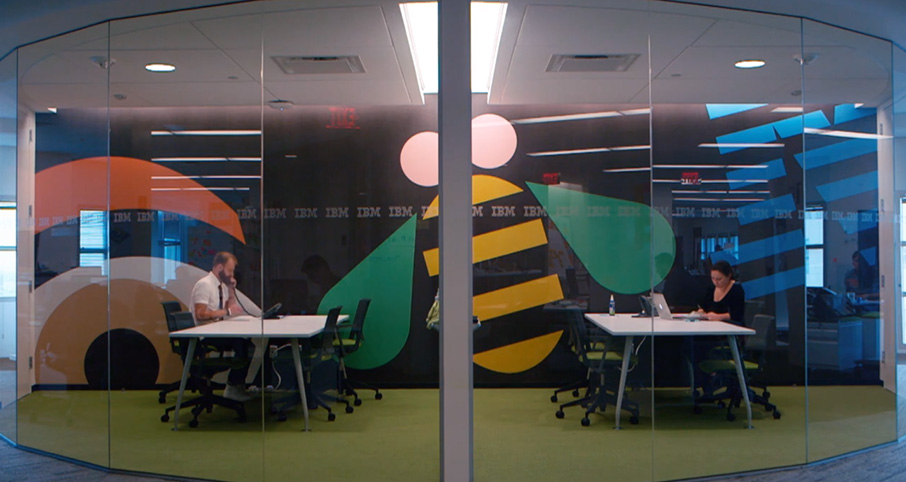
Imagine a world where business, technology and design come together to create products that actually make your work life more enjoyable and productive. It’s a place where great minds meld to treat customers—from data center technicians to programmers to end users—as individuals. Here, the word “you”is at the top of the development design board.
This is happening today at IBM via IBM Design, which was formed to scale great design across IBM’s extensive portfolio of enterprise software, hardware and services. Primarily located in a sleek, bright studio on the IBM campus in Austin, Texas, it’s where people from seemingly divergent disciplines come together to bridge the gap between essential functionality and simple usability.
IBM Design Vision Statements “Works Together” “Works the Same” “Works for Me”
As Charlie Hill, IBM Distinguished Engineer and CTO of IBM Design, explains, “This re-energized design philosophy within IBM is about teams embracing the mission to delight our users—and using all of the considerable skill sets we have on tap to do it. It’s a change in culture, a change in values, because everyone across our teams can relate to a better user experience—and you can feel that excitement, that motivating drive here at IBM Design.”
Breakthrough Ideas
This plays into IBM Design Thinking, which involves understanding how people live and work and then making sure the experience is tailored to those people. Prototyping this experience is crucial. It turns ideas into concrete designs, evaluates those designs to determine both usability and effectiveness, and then refines the designs based on what the designers have learned.
“Good design is good business.”—Thomas Watson Jr., son of IBM Founder Thomas J. Watson
The notion of radical collaboration is also key. This involves bringing product managers, engineers and designers together to explore user issues and potential solutions. The interplay between different disciplines brings fresh perspectives to the issue at hand, often leading to breakthrough ideas.
IBM’s first commercially available product based on Design Thinking was InfoSphere* Data Explorer (now called Watson Data Explorer). This big data exploration tool helps users distinguish between structured and unstructured data from multiple and diverse sources. Notably, this isn’t a back-office tool designed with only professional analysts in mind. Rather, it’s built to help front-line employees improve the customer experience.
Its development represented one of the first real applications of Design Thinking in IBM’s product portfolio. As Hill recalls, “The Data Explorer team was very modern in terms of development, but it had limited experience with design. So we brought product management, engineering and design together for the first-ever session of what we call Designcamp, where they learned about the IBM Design Thinking framework.”
During Designcamp, participants are asked to adopt three core practices. The first is defining “hills”for their projects. A hill represents a meaningful market outcome the team sets out to achieve within a defined time frame. The hills, of which there should be no more than three, allow the teams to focus on doing a few things well rather than spreading their effort too thinly over many competing goals.
Another practice involves “sponsor users.”In this case, a small number of trusted clients is invited into the development project to share their insights, provide feedback and help the team remain focused on solving real user problems, rather than the team guessing what those problems might be.
The third practice is called “playbacks.”This is where the team repeatedly walks through how actual users will accomplish specific goals using the solution under development. Initially, this is done using storyboards. As code is developed, the playbacks are performed on functioning bits of the solution, letting team members get a feel for how the product will be used and how it can be refined to further enhance user experience.
Works for Me
In the end, it’s the user that matters. We all want user experiences that make our jobs more enjoyable and productive. This core desire is reflected in IBM Design’s vision statements: “Works Together,”“Works the Same”and “Works for Me.”
“Works Together” applies to clients who use multiple IBM products. They want solutions that work in concert to solve end-to-end problems. “Works the same” has more to do with look and feel, where clients can expect IBM products to have both similar design cues and similar end-user interaction.
The third vision statement—“Works for Me”—is perhaps the most crucial. “Ultimately, our users want solutions that work for them and not solutions that confuse them or don’t live up to their expectations,”Hill says. “Within IBM Design, we’re embracing a very important mission: meeting and/or exceeding our users’expectations, even in the workplace.”





0 Comments